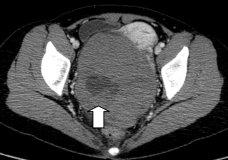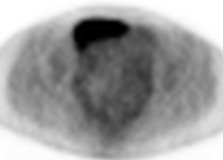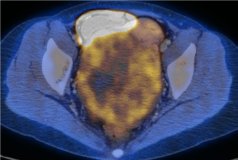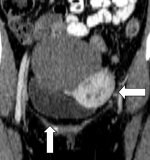Tumours that arise from ovarian stroma are known as fibroma-thecomas because of their usually mixed composition of fibroblasts (fibroma) and spindle cells with lipid droplets (thecoma). Such tumours comprise 4% of ovarian tumours, and are usually solid and unilateral. These tumours have 2 unusual associations. The first is Meigs syndrome, the constellation of ovarian fibroma (usually over 6cm), ascites and hydrothorax. The second is basal cell naevus syndrome (Gorlin syndrome), an autosomal dominant condition with multiple basal cell carcinomas.
For smaller tumours in the pelvis, PET-CT may sometimes have difficulty in distinguishing physiologic gastrointestinal activity from tumour uptake. FDG avidity can not be used alone to make the distinction, as physiologic gastrointestinal glucose metabolism may reach levels similar to that in malignant tumours. The uptake pattern must therefore also be used, with physiologic activity usually curved and non-focal.
In this case, the tumour is large and eumetabolic, which is its most common appearance, though these tumours are occasionally a cause of false positive interpretation (due to increased uptake) when investigating for malignancy.






